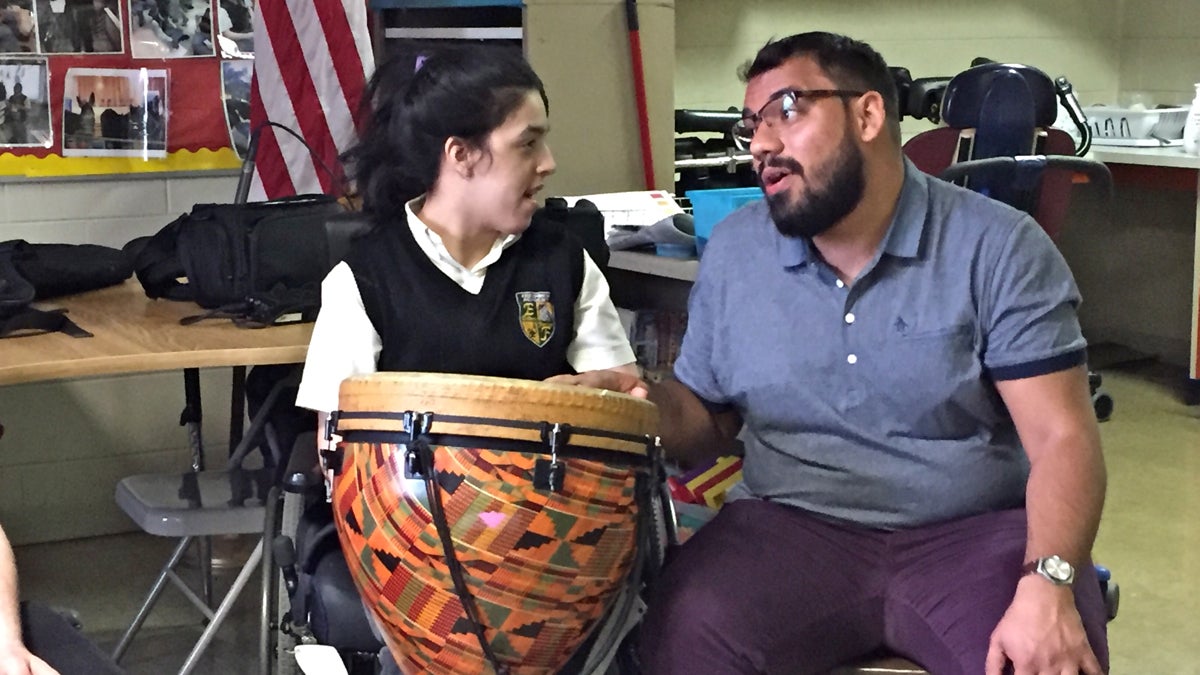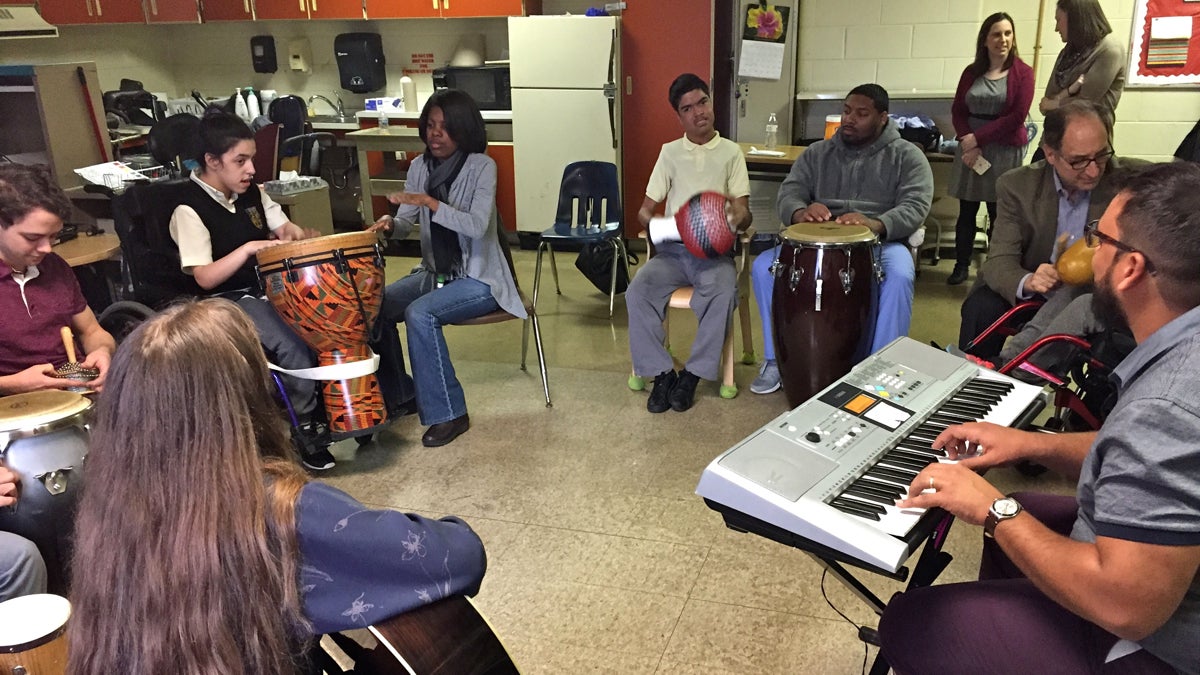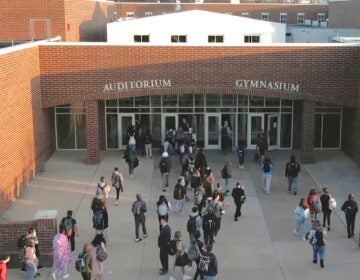How music therapy is helping Philly kids with multiple disorders connect with others
Listen
Juan Zambonini (right) sings with a student at Edison High School during a music therapy class. (Avi Wolfman-Arent/WHYY)
Deep in the bowels of North Philadelphia’s Edison High School — down a maze of hallways that twist and turn every which way–sits a small classroom of just four students.
Twice a week, on Tuesdays and Thursdays, this unassuming, dimly lit room transforms into an oasis of music and movement.
“It’s incredible,” said Jeff Gross, a special education teacher at Edison. “I think awesome’s an overused word. But it really is awesome.”
This transformation comes courtesy of three Temple students from the school’s music therapy program who spend an hour strumming and singing pop tunes. Their audience? A quartet of students who require what the School District of Philadelphia calls “multiple disabilities support” — meaning they have an IQ below 60 and a physical disability.
Across the city’s public school system only about 350 students are classified “multiple disability.” It is a rare label, reserved for those with some of the highest hurdles to learning. Among the students in Gross’s class, many struggle to speak or even move.
In rooms like these, progress isn’t measured in test scores or graduation rates, but instead in the subtlest sparks of communication: a glance, a nod, an uttered syllable.
“We’re talking about inches, not yards here,” said Gross.
To move the ball even that far forward, Gross figured his students needed a music class tailored to their specific needs. Enter the Temple trio, who started their bi-weekly visits to Edison in the fall.
The therapy sessions resemble campfire sing-a-longs, led by Juan Zambonini, a graduate student in Temple’s music therapy program. Two undergraduates–Shannan Morgan and Robert DiBartolomeo — accompany him while Gross’s students rap on an assortment of percussive instruments.
The result is cacophonous, but endearing. To the uninitiated, it looks like little more than a happy scene of amateur music-making.
But tucked throughout the session are hints of strategy.
Between songs, Zambonini asks students what they’d like to hear next. Often he’ll play a few chords on his piano and ask if the students like that song or not. Sometimes the responses are emphatic. Other times he’s met with blank looks.
“It was very important for us that they would choose the song. And in their own way,” Zambonini said.
The lesson is in the choosing, because it both requires the students to both recognize what is being played and find a way to communicate their approval of it.
At some points, mid-song, Zambonini attempts to coax a bit of singing from the students. Typically this works only in moments where a simple sound runs in repeat, like the “up up up” in Katy Perry’s “Firework” or the echo of “ella”s in Rihanna’s “Umbrella.”
For one student in a motorized wheelchair, Zambonini encourages her to use both hands while hitting a drum. It is a small victory, but a victory nonetheless.
“It’s a very exhausting exercise for her to use both hands,” Zambonini said. “If you noticed she kept her hand clenched to one side and just played with one hand. So I was trying to stimulate both hands. It wasn’t as much as do the beat right as just use both hands.”
The use of music therapy for special education students dates back to at least the 1970s, when the federal special education law first went into effect. But in Philadelphia its use remains limited. The school district said it knew of no other instance outside Edison where music therapists works with special needs students.
But the staff at Edison swear by the strategy.
“I’m amazed at the speech impact the therapy has had,” said Gross.
He sees it in little ways. Students who said nothing before now utter “no” or “bye.” Meredith Mathers, Edison’s special education liaison, glows about one student who can now give “high fives” in the hallway.
During the session it’s clear that most of the students can at least recognize the music. Some rock. Others sway.
Spasms of excitement pass through Ja’haad Maldonado, evidenced by frequent and furious hand gestures. He never quite says a recognizable word, but in his intermittent groans one can sense his struggle to verbalize. The music seems to unlock something inside him, perhaps only in a way he truly knows.
 A music therapy session at Edison High School. (Avi Wolfman-Arent/WHYY)
A music therapy session at Edison High School. (Avi Wolfman-Arent/WHYY)
To observe one of these therapy sessions is to witness the mystic universality of music, a thread through humanity that transcends language and intellectual capability.
It’s also a window into a seldom-explored corner of public education, where the goals seem both small and daunting.
Gross isn’t shepherding students toward college. He’s trying to get them to brush their own hair without resistance or say “hi” four times a day or identify the color orange.This type of teaching requires a proper sense of proportion and creativity. Gross has both in spades.
Along the walls of his classroom hang pictures of past outings and adventures. There’s the time a local weather woman visited to do arts and crafts. And of course the students haven’t forgotten the day Gross brought in alpacas from Bucks County.
“I’m not Mother Theresa, alright,” he said. “But if I find that things are stimulating for me..I can share that enthusiasm.”
Gross, a former shop owner who became a teacher only after his wife agreed to take over the business, is constantly on the prowl for new resources. He networks. He e-mails. He hustles to find anything that will help him break through.
Asked why, he shrugs. This is just what a teacher does.
“Someone said how’d you get the alpacas,” Gross recalled. “I said well the elephants were busy. But I try everyday to bring elephants to my kids.”
WHYY is your source for fact-based, in-depth journalism and information. As a nonprofit organization, we rely on financial support from readers like you. Please give today.





